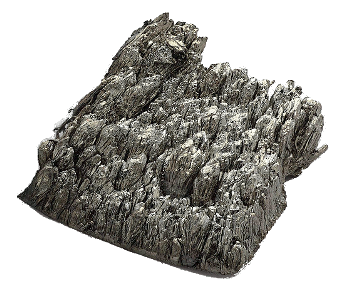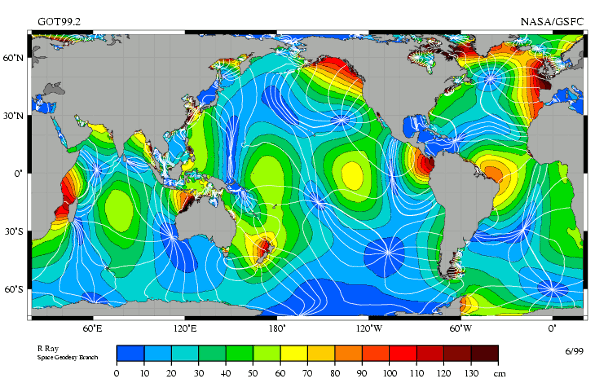Tidal Forces
June 20, 2012
There's a saying that
time and tide wait for no man. In a famous
anecdote about man
versus nature,
Cnut the Great,
king of
England,
Denmark, and other parts of
Scandinavia about a millennium ago, set his
throne at the
sea shore and
commanded the tide to halt. The
tide, of course, refused his command, and this was supposedly a lesson to his countrymen that kings are not as
omnipotent as some would hope. Perhaps
sea level change caused by
global warming will give a similar lesson to today's leaders.

Not much to look at, but very expensive to hold.
Scandium, named after King Canute's Scandinavia, is presently about $150 per gram.[1]
(Photo by Heinrich Pniok, via Wikimedia Commons)
Most people think of tides only in relation to
bodies of water, but the
Moon will exert forces on
sensitive equipment. In the
vacuum tube days, I read an article in which an
amateur radio operator tuned in a
frequency reference station on his
receiver and plotted the position of his
tuning dial versus the position of the Moon. There was a noticeable change.
In those days, tuned circuits were mechanical, using
variable capacitors and
inductors, so it's likely that he was measuring tidal forces. I think you would need to believe that the vacuum tubes and their cabinet provided a
constant thermal environment, and he wasn't really seeing
diurnal temperature variations.
How much of a force does the Moon exert on an 80
kilogram human? Plugging the Moon's
mass (7.345 x 10
22 kg), its distance from the
Earth (about 385,000
km), and the
gravitational constant G (6.674 x 10
-11 N m
2 kg
−2) into
Newton's gravitational equation,
F = G m1 m2 / r2 =
(6.674 x 10-11)(80)(7.345 x 1022)/(3.85 x 108)2 =
0.00265 newton =
0.27 gram-force
What all this means is that I'll weigh 0.0005 pounds less when the Moon is overhead, and 0.0005 pounds more when the Moon is underfoot. That change won't be detected on my
bathroom scale, but there are sensitive pieces of equipment that respond to tidal forces.
Pauline Gagnon, a member of the
CERN ATLAS team, reports in a recent blog article that the
Large Hadron Collider (LHC) must be adjusted to compensate for tidal forces.[2]
Tidal forces were also seen in the predecessor to LHC, the
Large Electron Positron collider (LEP). The cause is the differential tidal force seen at one side of the 27 km accelerator versus the other. This causes the circular accelerator to slightly alter shape, so the
proton beam would wander if corrections were not applied. the accelerator also deforms from changes in the water level of nearby
Lake Geneva.[2]
To illustrate how important tidal forces are, there are 872 papers posted on
arXiv with the word "tidal" in their title, 56 of which had been published up to June 10 of this year. Only four of the 872 address the Earth-Moon system. Although the Earth-Moon tidal system is presently not that
scientifically interesting, it's become
technologically very interesting because of the desirability of extracting
energy from the tides.

Amplitude of the tides, in centimeters. The white lines are co-tidal with a one hour time difference. NASA image by R. Ray, Goddard Space Flight Center, via Wikimedia Commons)
Needless to say, there's much
energy contained in the movement of the vast quantity of
ocean water (see figure, above). The two main methods to extract this energy are
tidal stream generators and
tidal barrage generators.
A tidal stream generator extracts energy from the movement of water during the
ebb and flow of the tides. Placement of
turbines underwater will extract this energy, and it's not hard to see that technologies that are used for wind energy harvesting can be applied to tidal energy harvesting. Tidal barrage generators work by trapping high tide water behind a dam for energy extraction by flowing the water through turbines at low tide.
All this energy is enough to get anyone excited, even cosmologists, who are not usually thought to be interested in things close to Earth.
Hermann Bondi, who is famous for the development of the
now-discredited steady-state theory of the universe, was chairman of a 1981 commission that studied the possibility of a
barrage on the
Severn estuary.
The committee proposed a 16 km (10 mile) long barrage, which would be a major engineering feat. This barrage would have generated more than 7
gigawatts, which is the equivalent power output of nearly ten
nuclear power plants, but it was never built.
References:
- Daniel J. Cordier, "Scandium," US Geological Survey, Mineral Commodity Summaries, January, 2012).
- Pauline Gagnon, "Is the moon full? Just ask the LHC operators," Quantum Diaries, June 7, 2012
Permanent Link to this article
Linked Keywords: Time and tide wait for no man; anecdote; Cnut the Great; monarch; king; England; Denmark; Scandinavia; throne; sea shore; ruler of the waves; tide<; omnipotence; omnipotent; current sea level rise; sea level change; global warming; scandium; King Canute; Heinrich Pniok; Wikimedia Commons; body of water; Moon; scientific instrument; sensitive equipment; vacuum tube; amateur radio operator; WWV; frequency reference station; receiver; tuner; tuning dial; variable capacitor; variable inductor; thermal reservoir; constant thermal environment; diurnal temperature variation; kilogram; human; mass; Earth; kilometer; km; gravitational constant; newton; Newton's gravitational equation; gram-force; bathroom scale; Pauline Gagnon; CERN; ATLAS; Large Hadron Collider; Large Electron Positron collider; proton; Lake Geneva; arXiv; science; technology; tidal power; energy from the tides; centimeter; NASA; Goddard Space Flight Center; energy; ocean; tidal stream generator; tidal barrage generator; ebb and flow; electric generator; turbine; Hermann Bondi; Big Bang; steady-state; barrage; Severn estuary; gigawatt; nuclear power plant.